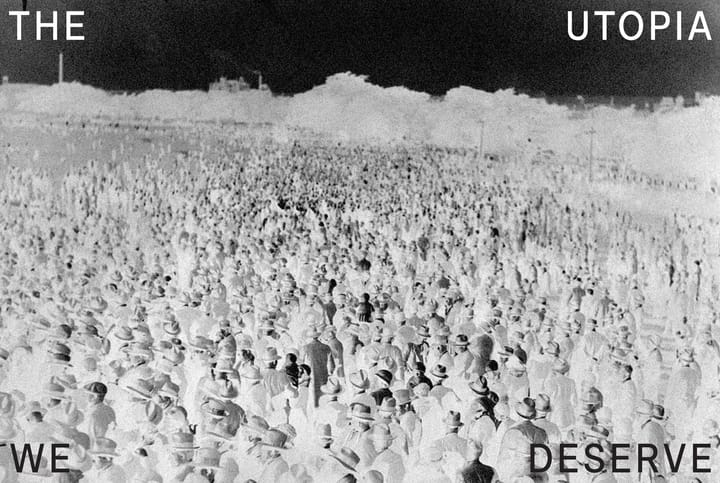Touching Grass in Dallas
Dealey Plaza remains one of the Works Progress Administration's most overlooked masterpieces.

In the heart of Dallas, a triangular landscaped park separates the downtown grid from a tangle of highways and the lazy passage of the Trinity River. Named after G.B. Dealey, publisher of the Dallas Morning News, Dealey Plaza forms a reverse trident that brings together the city’s three oldest thoroughfares until they dissolve into a single street.
While Dealey Plaza is basically a regal version of the nondescript geometries of grass, weeds, and detritus that cushion the highways that spread like overgrowth around American cities, it is nevertheless a key part of the city’s plan and a major area of interest that draws thousands of visitors a year. If you seek out its slightly sloping hills today, you’ll see a man struggling to set up a camera tripod, a woman pushing a stroller, and people making gestures to one another, as if to guide each other’s gaze to particular angles of sight. Someone in the distance opens an umbrella, though it hasn’t rained in weeks.
Dealey is known as the “Birthplace of Dallas.” One plaque reads: “Within this small park was built the first home, which also served as the first courthouse and post office, the first store, and the first fraternal lodge. Dedicated to the pioneers of civic progress by order of the park board.” The authors of the WPA Guide to Dallas describe Dallas as both a conservative city and a “young, vigorous, and rich” place that has “almost obliterated every vestige of the past.” They compare it to “Zenith,” the fictional town in Sinclair Lewis’ Babbitt.
Dallas was carved out of the fertile, Blackland Prairie landscape as a commercial midpoint between East and West. The surrounding area proved to be a fabulous place to grow cotton, making Dallas a trading post in the 19th century. The city next grew as a hub for insurance and banking, funneling money from eastern elites to the burgeoning American West. And, of course, there is oil. Rich and powerful people are known to follow this resource with an intense worship. They chase it at the bottom of the ocean and miles into the earth’s infernal underbelly. They have invented some of the most advanced engineering instruments known to man to scavenge the dead matter of vast ancient seas and hundreds of millions of years of pressurized primordial muck. Almost half of American oil comes from the hulking rigs that dot the Permian Basin that bleeds into West Texas. But this rich carnage is more an invisible power in Dallas. Fuel here is transformed into money and political power, and along with oil came the defense industry. Companies like Dresser Industries, DeGolyer and MacNaughton, and Geophysical Service Inc. (later Texas Instruments) were based in Dallas alongside powerful entities like the Dallas Council on World Affairs—some with offices just blocks away from Dealey. In fact, Texas School Book Depository owner D. Harold Byrd was a well-connected oilman.
Another plaque draws your attention to a brighter part of Dealey Plaza’s history. It reads simply “Works Projects Administration 1938-1940,” commemorating the New Deal project that built the park. In 1935, as part of the “Second New Deal,” President Franklin Delano Roosevelt established the WPA and tasked it with providing jobs for Americans who were not being gainfully employed by private enterprise. The WPA developed a staggering number of projects across the country, from infrastructure to cultural programs to education, administration, and public health. The government hired people to build irrigation systems, energy infrastructure, dams, sewage plants, roads, airports, educational and administrative buildings, bridges, and recreational infrastructure like athletic fields, playgrounds, parks and swimming pools.
The WPA had dozens of projects in Dallas alone, including Dealey. Curious citizens still come every year to admire this simple, manicured aperture for the Dallas skyline. Dealey Plaza stands as a monument to one of the rare moments in American history when the state executed a concrete, common sense plan to help people in an immediate way. Unfortunately, the principle that guided the WPA—that government should be used to make society more beautiful and functional for everyone—is decades in retreat. More than good politics, WPA projects were constitutive of a new fabric of civil society. Not only did they build, beautify and educate, they created a new terrain for human flourishing.
This era is worth returning to. With so many challenges in need of collective action, it is important to find historical periods when constructive civil impulses were able to overcome government dysfunction and capitalist interests, to roll back commodified space and build for the common good. It is good politics to help people build something to be proud of—an inherently positive, socializing process in a time of widespread alienation.
■
Chris Crawford is a Damage contributor living in New York.



